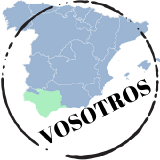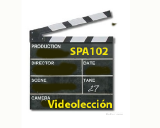4.5: Los objetos directos y los pronombres de los objetos directos
- Page ID
- 150045
Direct object nouns and direct object pronouns
Direct objects
In a sentence, the "direct object" is what/whom the verb affects "directly." A direct object can be "people, animals, things, ideas, or events."
The photos below shows a typical sentence in Spanish, which usually begins with a subject/pronoun followed by a verb. If there is a direct object in the sentence, it usually follows the verb. To identify a direct object in a sentence, create a question out of the sentence using what (left photo) or whom (right photo). For example, "What do I study? In this case, the answer is Spanish/español, which means that the direct object is "español." Similarly, using the example in the photo on the right, if you make this into a question "To Whom do I listen/Whom do I listen to," the answer is "the children/a los chicos."
¡OJO! In Spanish, if the direct object noun is a person or a pet, it is preceded by the word "a" which is called the "personal a"; there is no English equivalent for this construction.

Direct object pronouns/los pronombres de objeto directo
Direct Object Pronouns are words that replace direct objects to avoid repeating a noun already mentioned. The direct object pronouns in Spanish are presented in the chart below. For information on the regional forms "vos" and "vosotros", click the relevant icons.
| Singular | Plural |
|---|---|
| me = me | nos = us |
te = you  |
 |
| lo = you (m.); him; it (m.) | los = you (m.); them (m.) |
| la = you (f.); her; it (f.) | las = you (f.); them (f.) |
For anyone who prefers not to use the traditional masculine or feminine forms, "lo/los" or "la/las" when referring to individuals, you can use the forms "le/les".
Placement of the direct object pronouns (DOP)
Direct object pronouns have a particular place in a Spanish sentence depending on the number of verbs. Observe the differences between English and Spanish below:
| English: | Spanish: |
|---|---|
|
Subject/Pronoun + Verb + Direct Object Pronoun Carmen speaks it. [Spanish] We hear them. [the boys] |
Subject/Pronoun + Direct Object Pronoun + Verb Carmen lo habla. [lo = español] Los escuchamos. [los = los chicos] |
One Verb
If there is only ONE verb in the sentence, the direct object pronoun (DOP) marked in blue, is placed before the conjugated verb (but after the subject, if one is included). If the sentence is negative, the negative word "no" precedes the DOP:
Subject/Pronoun + DOP + Verb
Carmen (no) lo habla. [lo = español]
(No) los escuchamos. [los = los chicos]
Two Verbs
If there are two verbs in the sentence, then the speaker has two options:
OPTION 1: When the main verb is followed by an infinitive or the verb is in the present progressive (estar + present participle), place the DOP before the conjugated verb.
OPTION 2: When the main verb is followed by an infinitive or the verb is in the present progressive (estar + present participle), attach the pronoun to the infinitive or present participle***
***When a pronoun is attached to a present participle, an accent mark is added on the a of the "ando" ending or the e of the "iendo" ending.
| Subject Pronoun + DOP + Verb in the infinitive | OR | Subject Pronoun + Verb in the infinitve+DOP |
|---|---|---|
|
Carmen lo va a hablar. [lo = español] Los vamos a ver. [los = los chicos] |
OR OR |
Carmen va a hablarlo. [lo = español] Vamos a verlos. [los = los chicos] |
| Subject Pronoun + DOP + Verb in the present progressive | OR | Subject Pronoun + Verb in the present progressive+DOP |
|---|---|---|
|
Carmen lo está hablando. [lo = español] Los estamos escuchando. [los = los chicos] |
OR OR |
Carmen está hablándolo. [lo = español] Estamos escuchándolos. [los = los chicos] |
Commands
When using Direct Object Pronouns with the informal tú commands (Click here to review), the speaker has two options depending on whether it is an affirmative or negative command. Look at the charts below.
| Affirmative Commands | Negative Commands |
|
|
What do you observe about the placement of the direct object pronoun and why do you add an accent?
- Respuesta
-
With Affirmative Commands the pronoun is attached to the back of the verb.
Since the DOP adds an additional syllable to the word, with verbs of more than one syllable, you have to add a written accent mark on the syllable that originally had the main accent. If you say the word, "escribe", you stress the "i". In order to keep the stress on that syllable, you need to add a written accent.
Escribe > escribe + lo > escríbelo
Videolección
 |
By clicking on the icon to your left, you can hear a video lesson about direct objects and direct object pronouns. |
¡A practicar!
Decide qué palabra es el objeto directo en cada frase y después reescribe la frase usando un pronombre.
1. Veo a María
2. Leyeron las noticias por la mañana.
3. Escribiste el ensayo.
4. Hizo el dibujo ayer.
5. Estaban escuchando la música.
6. Necesitan contestar el teléfono.
7. Estás mirando los cuadros en el museo.
- Respuestas
-
1. Veo a María
La veo.2. Leyeron las noticias por la mañana.
Las leyeron por la mañana.3. Escribiste el ensayo.
Lo escribiste.4. Hizo el dibujo ayer.
Lo hizo ayer.5. Estaban escuchando la música.
La estaban escuchando/Estaban escuchándola.6. Necesitan contestar el teléfono.
Lo necesitan contestar/Necesitan contestarlo7. Estás mirando los cuadros en el museo.
Los estás mirando en el museo/Estás mirándolos en el museo.
Actividad 2 ¿Qué hiciste durante tu viaje?
Susana acaba de regresar de Puerto Rico y su amigo Jorge tiene muchas preguntas y quiere saber lo que hizo durante su viaje. En parejas alguien hace el papel de Jorge y otra persona hace el papel de Susana. "Jorge" usa los elementos de la columna A para hacer por lo menos cinco preguntas y "Susana" las contesta usando un pronombre de objecto directo y debe tratar de añadir detalles especialmente si contesta "no" a unas de las preguntas para explicar por qué no hizo algo.
Ejemplo: Jorge: ¿Viste "La brisa tropical" de Yauco?
Susana: Sí, la vi durante mi visita al "pueblo del café".
| Columna A - Jorge | Columna B - Susana |
| ¿Ver el museo? | Sí, ... |
| ¿Visitar el castillo San Felipe de Morro en San Juan? | Sí, ... |
| ¿Alquilar un coche? | No, ... |
| ¿Bailar la salsa? | No, ... |
| ¿Poder comprar los recuerdos? | Sí, ... |
| ¿Comer los platos típicos puertorriqueños? | No, ... |
Actividad 3 Un juego - ¿Quién lo tiene?
En grupos de cuatro estudiantes. Tres de los cuatro estudiantes deben buscar cuatro objetos en su mochila. (Es posible que su profesora les traiga otras cosas.)
Unx de lxs estudiantes es el/la afitrión/a del juego y puede ver todos los objetos. Empieza el juego con una pregunta y una persona puede contestar con una frase completa usando el pronombre del objeto directo apropiado. La primera persona que conteste la pregunta correctamente gana un punto.
Modelos: Estudiante -Anfitrión/a: ¿Quién tiene el lápiz?
Estudiante jugador/a : Yo lo tengo
Estudiante -Anfitrión/a: ¿Quiénes tienen los libros?
Estudiante jugador/a: Pedro y Guillermo los tienen.
Actividad 4 - ¿Dónde lo encontraron?
En parejas van a buscar varios objetos en la oficina. Al encontrar cinco de los objetos, deben describir donde lo encontraron.
Modelo: El pájaro.
Lo encontramos en su jaula

Elementos para encontrar:
| la grapadora | los trofeos | el cinturón | la llave |
| el paraguas | las monedas | el violín y el paraguas | la pluma de un pájaro |
| la mochila | la cámara | el gato | el caballo |
Contributors
Elements of this page have been adapted from the following sources:
Los objetos directos y los pronombres de los objetos directos is shared under a CC BY-NC-SA 4.0 license and was authored, remixed, and/or curated by M. Barrio De Mendoza, K Gutiérrez, H.Ho, C. Lin, & A Stere Lugo (ASCCC Open Educational Resources Initiative).
Pronombres de objeto directo is shared under a CC BY-NC-SA license and was authored, remixed, and/or curated by Nancy Ballesteros, Alejandro Lee, Nicolás Crisosto, & Cristina Moon (ASCCC Open Educational Resources Initiative)
Photo from https://commons.wikimedia.org/wiki/File:Hidden_object_game.jpg licensed under CC-0 Public Domain.

